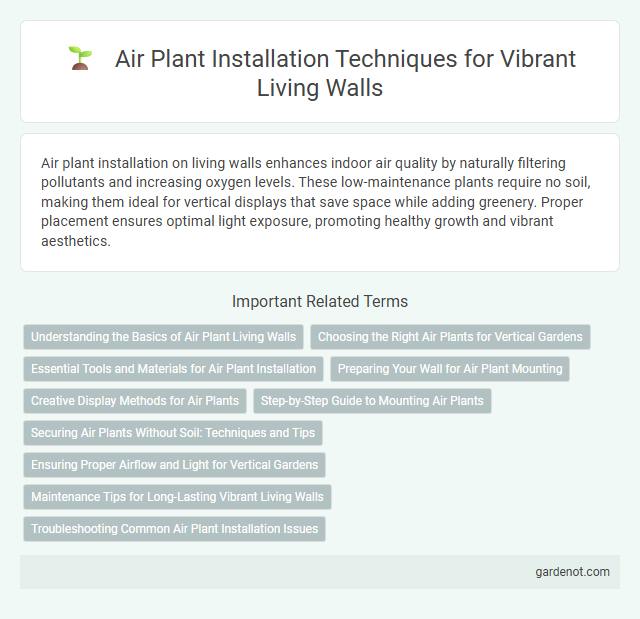Air plant installation on living walls enhances indoor air quality by naturally filtering pollutants and increasing oxygen levels. These low-maintenance plants require no soil, making them ideal for vertical displays that save space while adding greenery. Proper placement ensures optimal light exposure, promoting healthy growth and vibrant aesthetics.
Understanding the Basics of Air Plant Living Walls
Air plant living walls consist of Tillandsia species that thrive without soil, absorbing moisture and nutrients through their leaves. These unique plants require minimal maintenance, needing only indirect light and regular misting or soaking to maintain hydration. Proper installation involves securely mounting plants on breathable surfaces like wood or mesh, ensuring airflow and preventing moisture buildup to promote healthy growth.
Choosing the Right Air Plants for Vertical Gardens
Selecting air plants (Tillandsia) with varying sizes and leaf textures enhances the visual appeal of living walls while ensuring optimal light absorption. Species like Tillandsia ionantha and Tillandsia xerographica thrive in vertical garden conditions due to their adaptability and low maintenance requirements. Proper consideration of humidity levels and airflow is essential to promote healthy growth and prevent rot in air plant installations.
Essential Tools and Materials for Air Plant Installation
Essential tools for air plant installation include a moisture meter, precision scissors, and a small spray bottle to maintain optimal hydration levels. Materials such as sphagnum moss, wire frames, and non-toxic adhesives ensure secure and healthy placement on living walls. Proper selection of these tools and materials supports air plants' air circulation and moisture needs, promoting thriving vertical gardens.
Preparing Your Wall for Air Plant Mounting
Preparing your wall for air plant mounting involves selecting a sturdy surface such as wood, corkboard, or mesh that provides adequate support and airflow. Clean the wall thoroughly to remove dust and moisture, ensuring better adhesive or fastening results. Use mounting supplies like floral wire, glue dots, or specialized air plant holders to secure the plants without damaging their delicate roots.
Creative Display Methods for Air Plants
Air plant installation offers versatile creative display methods, including mounted driftwood frames, geometric glass terrariums, and vertical garden walls that maximize space and visual impact. Utilizing natural materials like cork bark or reclaimed wood enhances the aesthetic while providing a stable base for the Tillandsia species. Incorporating magnetic holders or wire grids allows dynamic arrangements and easy repositioning, fostering a personalized and sustainable living wall design.
Step-by-Step Guide to Mounting Air Plants
Begin by selecting a sturdy base such as driftwood, cork bark, or a wire frame suitable for mounting air plants. Secure the air plants using non-toxic adhesives, floral wire, or fishing line, ensuring the roots remain exposed to allow proper airflow and moisture absorption. Position the mounted air plants in an area with bright, indirect light and maintain regular misting or soaking to promote healthy growth.
Securing Air Plants Without Soil: Techniques and Tips
Securing air plants without soil involves using materials like wire, fishing line, or non-toxic glue to attach them to a living wall framework, such as wood, metal, or mesh. Frequently, air plants are mounted on cork bark, driftwood, or moss to provide support while allowing airflow and moisture retention essential for their health. Proper placement ensures the plants receive adequate light and humidity, promoting longevity and vibrant growth in living wall installations.
Ensuring Proper Airflow and Light for Vertical Gardens
Air plant installation in living walls demands careful positioning to maximize airflow and exposure to indirect light, essential for healthy growth. Vertical garden designs must incorporate spacing that prevents moisture buildup and promotes circulation, reducing the risk of rot and pest infestations. Selecting locations near natural light sources or integrating supplemental LED grow lights enhances photosynthesis, supporting vibrant and sustainable vertical ecosystems.
Maintenance Tips for Long-Lasting Vibrant Living Walls
Air plant installation in living walls requires consistent misting or soaking every 1-2 weeks to maintain optimal hydration and prevent desiccation. Ensuring adequate indirect light exposure and proper airflow helps avoid mold growth and supports healthy photosynthesis. Regularly inspecting for dead or damaged foliage and gently cleaning debris can promote vibrant, long-lasting air plant displays.
Troubleshooting Common Air Plant Installation Issues
Air plant installation in living walls often faces challenges like poor adherence, improper watering, and insufficient light exposure, leading to plant stress or death. Ensuring secure mounting with non-toxic adhesives or wire supports, maintaining adequate misting schedules, and placing the plants in indirect sunlight can mitigate common issues. Regular inspection for pests and rot helps detect problems early and sustains healthy air plant growth in vertical gardens.
Air plant installation Infographic

 gardenot.com
gardenot.com